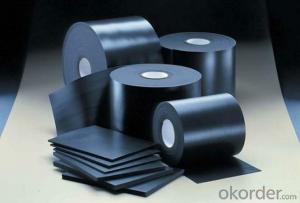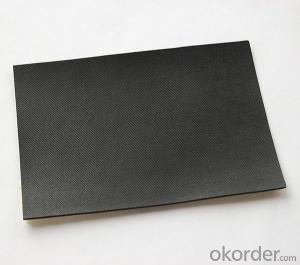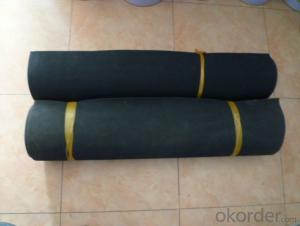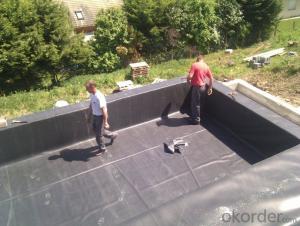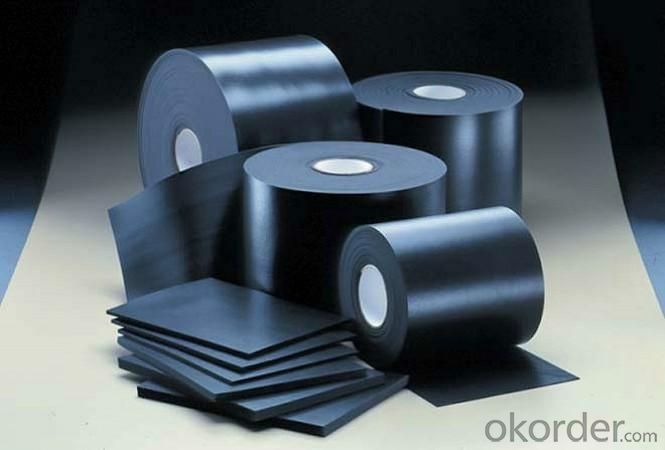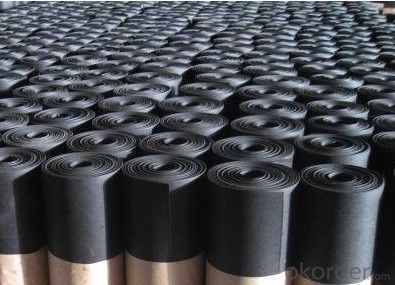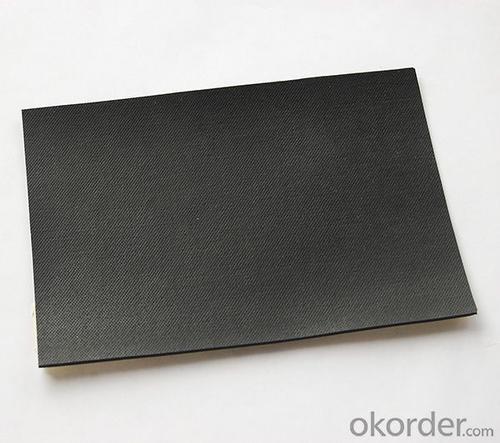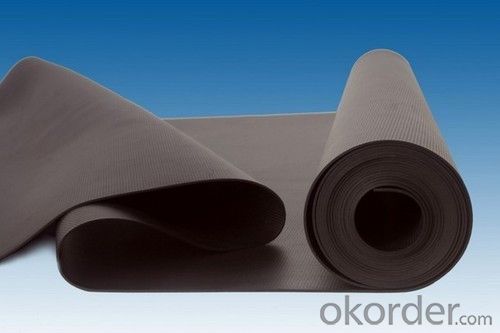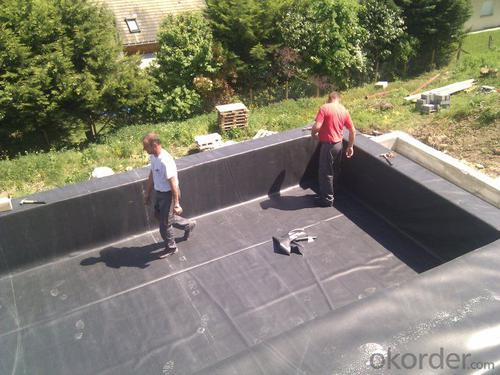EPDM Waterproof Membrane with 1.2mm for Roof Project
- Loading Port:
- Shanghai
- Payment Terms:
- TT OR LC
- Min Order Qty:
- 20000 m²
- Supply Capability:
- 5000000 m²/month
OKorder Service Pledge
OKorder Financial Service
You Might Also Like
EPDM Waterproof Membrane with 1.2mm for Roof Project
Description Of EPDM Waterproof Membrane with 1.2mm for Roof Project:
1. EPDM waterproof membrane is made from ternary ethylene-propylene rubber, which is for waterproofing of exposed and non-exposed applications.
2. EPDM waterproof membrane production adopts the world-advanced equipment of cold feeding extrusion and continuous vulcanization technology.
3. EPDM waterproof membrane is of high elasticity among high polymer waterproof materials and becomes a world-popular waterproofing material.
Main Features of EPDM Waterproof Membrane with 1.2mm for Roof Project:
1.Excellent anti aging performance ,service life up to 50 years.
2.High extension rate,high tensile strength ,small size changes at heat treatment.
3.Good plant roots penetrability resistance and can be made waterproofing layer of planting roof.
4.Special modified molecular structure ,effectively resolving the current domestic and foreign glue joint problem.
5.Good low temperature flexibility ,and good performance of adapting to ambient temperature changes.
6.Convenient application ,solid joint ,no environment pollution.
7.Chemical corrosion resistance ,can be used for special occasions.
8.Good anti-perforated.
Specifications of EPDM Waterproof Membrane with 1.2mm for Roof Project:
| Material | EPDM Rubber |
| Size | 1.2m (width)*20m (length) or customized, weldable type 2.05m or 4m width |
| Thick | 1.2mm, 1.5mm, 2.0mm |
| Type | Vulcanized & Weldable |
| Pattern | Non-reinforced (homogeneous) |
| Certificate | ISO9001/14001 |
Applications of EPDM Waterproof Membrane with 1.2mm for Roof Project:
1. Roofs, Basement, Toilet
2. Industrial and civil building waterproofing
3. Geo-synthetic liner for swimming pool, channels, irrigation system
4. Especially suit for projects with high requirements in durability, anti-corrosion and deformation
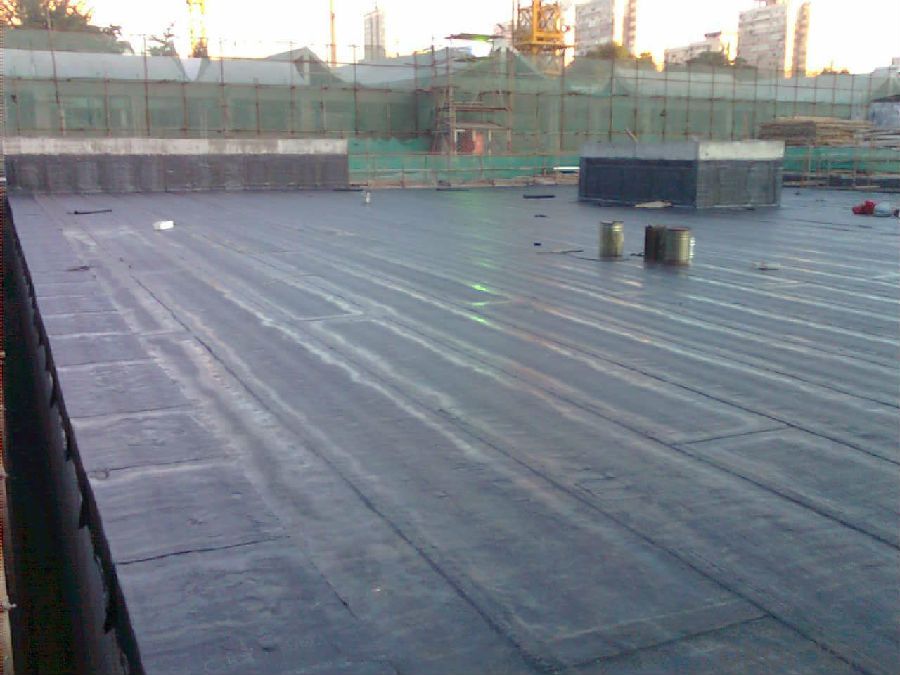
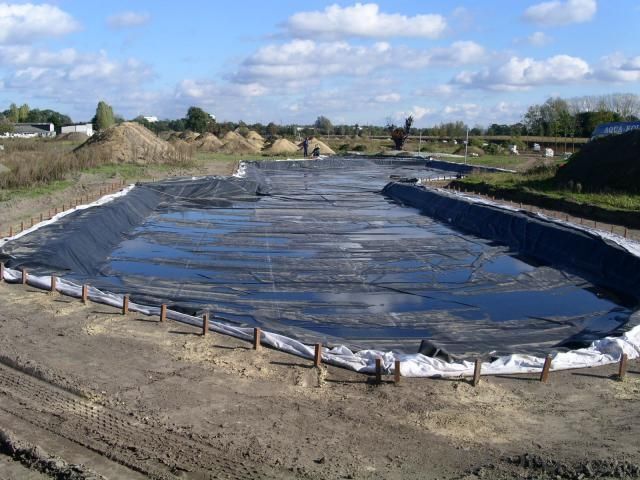

IMages of EPDM Waterproof Membrane with 1.2mm for Roof Project:
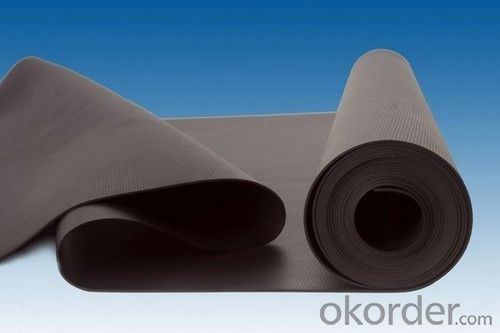



FAQ of EPDM Waterproof Membrane with 1.2mm for Roof Project:
1. What are we supplying?
We are specialized in producing Colorful Asphalt Roof Shingle, SBS/APP modified bitumen waterproof membrane, Self adhesive bitumen waterproof membrane, PVC waterproofing membrane, EPDM rubber roofing membrane, Single Component Polyurethane Waterproof Coating, and Spray Polyurea Waterproof Coating
.
2. How Many years experience do we have?
We have been exported to more than 20 countries in the past 15 years.
3. How long do we usually reply your request?
We always reply our customer within 24 hours.
- Q: Are waterproofing membranes resistant to frost damage?
- Yes, waterproofing membranes are designed to be resistant to frost damage. They are typically made from durable materials that can withstand freezing temperatures without cracking or deteriorating.
- Q: Can a waterproofing membrane be used in mining or excavation projects?
- Yes, a waterproofing membrane can be used in mining or excavation projects. Waterproofing membranes are designed to prevent the penetration of water or other liquids, making them suitable for protecting underground structures, tunnels, or mining areas from water ingress. They can help to maintain the stability and integrity of the excavation site, preventing water-related damages and ensuring safety.
- Q: Are waterproofing membranes suitable for underground parking garages?
- Underground parking garages necessitate waterproofing membranes due to their constant exposure to groundwater and moisture. These factors can result in water infiltration and structural damage. Waterproofing membranes offer an effective solution to prevent water penetration and safeguard the concrete structure from deterioration. The purpose of waterproofing membranes is to establish a barrier against water and moisture, effectively barring their entry into the garage. These membranes are commonly applied to the parking garage's exterior walls, foundation, and floor slab. They are crafted from durable materials like modified bitumen, polyurethane, or rubberized asphalt, capable of withstanding the harsh conditions of underground environments. By incorporating waterproofing membranes into underground parking garages, the likelihood of water damage, such as concrete cracking, reinforcement steel corrosion, and mold growth, is significantly reduced. The membranes serve as a protective layer, guaranteeing the longevity and structural integrity of the parking garage. Moreover, waterproofing membranes can also aid in minimizing vapor transmission, which may trigger condensation and humidity problems within the parking garage. This is especially crucial for underground parking garages located in regions with high water tables or susceptible to heavy rainfall. All in all, waterproofing membranes are an indispensable aspect of constructing or renovating underground parking garages. They offer a dependable and enduring solution to shield the structure from water infiltration, ensuring the safety and durability of the parking facility.
- Q: Can a waterproofing membrane be used for a basement wall?
- Certainly, a basement wall can indeed benefit from the use of a waterproofing membrane. It is highly advisable to employ such a membrane on basement walls in order to thwart water infiltration and potential harm. Given their subterranean position, basement walls are especially susceptible to moisture; thus, a waterproofing membrane serves as a reliable barrier against water penetration. Typically, this membrane is applied to the exterior surface of the basement wall, forming a protective layer that maintains the basement's dryness and hinders water from seeping into the foundation. It is imperative to ensure the proper installation and upkeep of the waterproofing membrane to effectively protect the basement against water-related problems such as leaks, mold, and structural damage.
- Q: Can a waterproofing membrane be used in historical or heritage buildings?
- Yes, a waterproofing membrane can be used in historical or heritage buildings. However, it should be done with caution and expertise to ensure that the membrane does not compromise the historical integrity or aesthetic value of the building. The selection and installation of the membrane should be carried out by professionals who understand the specific requirements and challenges associated with preserving the architectural significance of such buildings.
- Q: How long do waterproofing membranes last?
- The lifespan of waterproofing membranes can differ based on a variety of factors including the type of membrane utilized, the quality of installation, environmental conditions, and maintenance practices. Typically, high-quality waterproofing membranes have a lifespan ranging from 10 to 50 years. As an illustration, bituminous membranes, commonly employed in roofing applications, generally last around 20 to 30 years. Conversely, more advanced synthetic membranes like PVC or TPO can endure for up to 40 years or possibly longer. Nevertheless, it is essential to recognize that these estimates are contingent upon optimal conditions and regular maintenance. Factors such as exposure to extreme weather, improper installation, insufficient maintenance, or physical damage can significantly diminish the lifespan of the membranes. Consequently, it is vital to seek guidance from professionals and adhere to the manufacturer's maintenance recommendations in order to ensure the longevity of the waterproofing membranes.
- Q: Are waterproofing membranes suitable for below-grade applications?
- Yes, waterproofing membranes are suitable for below-grade applications. Waterproofing membranes are specifically designed to prevent the infiltration of water into below-grade structures such as basements, foundations, and retaining walls. These membranes are made from durable materials that can withstand the pressure of soil and water, ensuring long-term protection against leaks and water damage. They are typically installed on the exterior side of the below-grade structure to create a barrier that prevents water from seeping through the walls or floors. Additionally, waterproofing membranes are flexible and can accommodate structural movements, ensuring their effectiveness even in challenging below-grade environments. Overall, waterproofing membranes are a reliable and effective solution for protecting below-grade structures from water intrusion.
- Q: Are there different waterproofing membrane options for above-ground and below-ground applications?
- Yes, there are different waterproofing membrane options available for above-ground and below-ground applications. Above-ground applications typically involve waterproofing structures such as roofs, balconies, or walls. For these applications, commonly used waterproofing membrane options include liquid-applied membranes, sheet membranes, and polyurethane membranes. These membranes are designed to withstand exposure to weather elements such as UV rays, temperature changes, and foot traffic. On the other hand, below-ground applications involve waterproofing structures like basements, foundations, or tunnels. Below-ground waterproofing membranes are specifically designed to withstand hydrostatic pressure from the surrounding soil and groundwater. These membranes are typically thicker and more durable than above-ground membranes. Commonly used below-ground waterproofing options include bituminous membranes, bentonite clay membranes, and composite membranes. It is important to choose the right waterproofing membrane for each specific application as the requirements and challenges can vary. Consulting with a waterproofing professional or engineer can help determine the most suitable membrane option for both above-ground and below-ground applications.
- Q: Can a waterproofing membrane be used in conjunction with expansion joint systems?
- Yes, a waterproofing membrane can be used in conjunction with expansion joint systems. Waterproofing membranes are commonly used to prevent water infiltration and protect structures from moisture damage. Expansion joint systems, on the other hand, are installed to allow for movement and accommodate thermal expansion and contraction in structures. By combining the use of a waterproofing membrane and expansion joint systems, it is possible to provide both waterproofing and movement accommodation in a structure. This ensures that the structure remains protected from water damage while allowing for necessary movement. It is important to properly design and install both the waterproofing membrane and the expansion joint system to ensure their compatibility and effectiveness.
- Q: Can a waterproofing membrane be used on precast cement board surfaces?
- Precast cement board surfaces, commonly utilized in construction, particularly for exterior applications, can benefit from the application of a waterproofing membrane. These surfaces are not inherently waterproof, making it necessary to add an extra layer of protection against water infiltration. The waterproofing membrane, a thin material layer, serves as a barrier on the cement board surface. Its primary function is to prevent water from penetrating the board and reaching the underlying structure. This becomes particularly crucial in areas exposed to moisture, such as bathrooms, kitchens, and outdoor installations. Various types of waterproofing membranes are available, including liquid-applied membranes and sheet membranes. Liquid-applied membranes can be rolled or sprayed onto the surface, while sheet membranes are applied similarly to stickers. Both options effectively waterproof precast cement board surfaces. When selecting a waterproofing membrane for precast cement board surfaces, it is vital to consider the specific requirements and conditions of the project. Factors such as water exposure level, climate, and intended use of the surface should be taken into account. Following the manufacturer's instructions for application is also crucial, as proper installation significantly impacts the membrane's effectiveness. To summarize, the utilization of a waterproofing membrane on precast cement board surfaces provides an additional safeguard against water infiltration. This wise choice is especially beneficial in moisture-prone areas, ultimately extending the lifespan of the cement board and preventing harm to the underlying structure.
Send your message to us
EPDM Waterproof Membrane with 1.2mm for Roof Project
- Loading Port:
- Shanghai
- Payment Terms:
- TT OR LC
- Min Order Qty:
- 20000 m²
- Supply Capability:
- 5000000 m²/month
OKorder Service Pledge
OKorder Financial Service
Similar products
Hot products
Hot Searches
Related keywords
